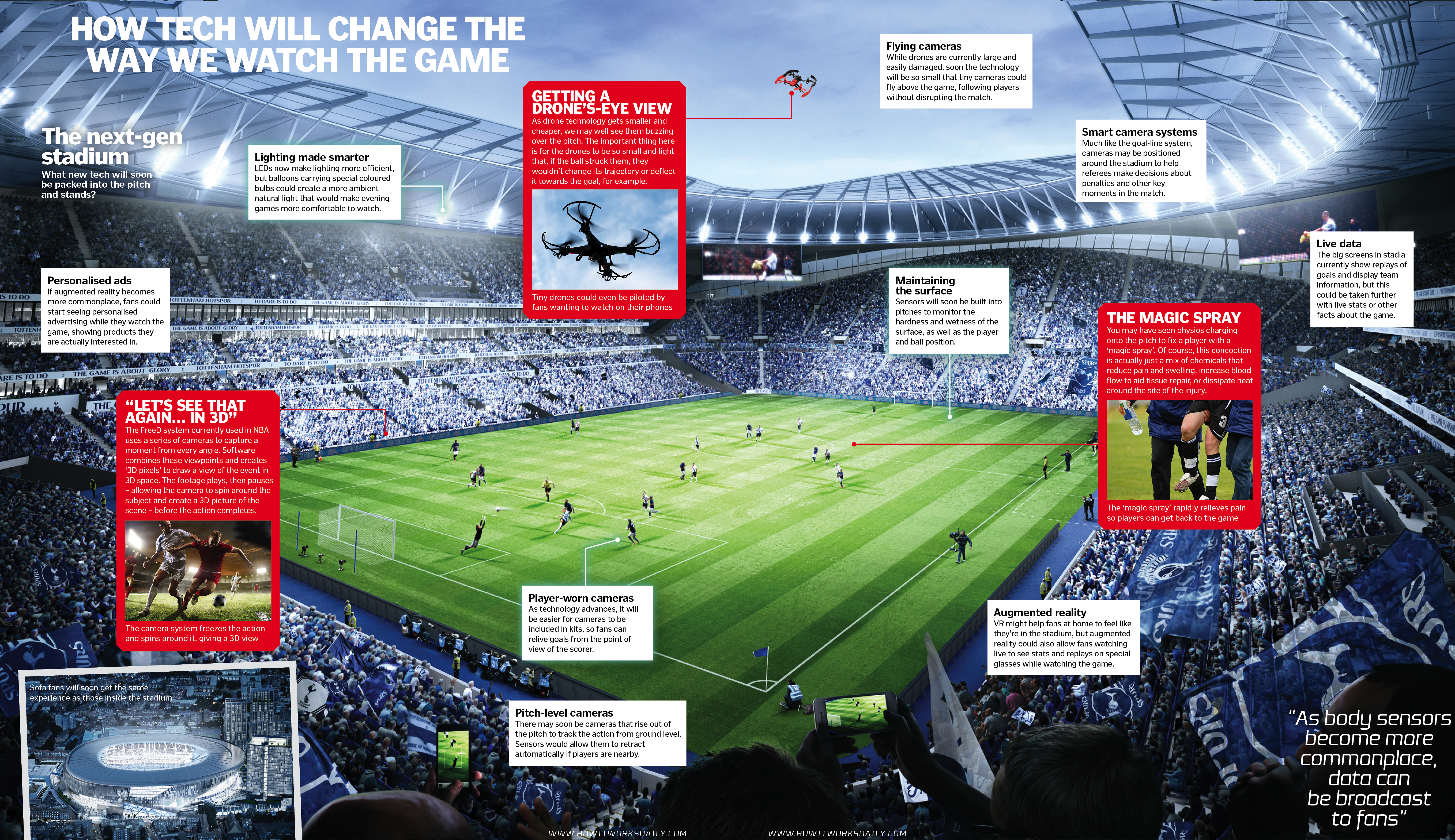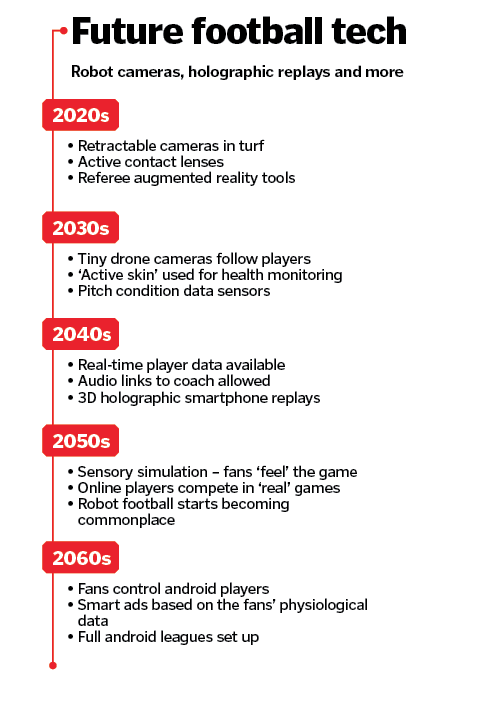The future of football
Revealed: the tech and tactics that will take teams straight to the top!
Picture it now: it’s the 2050 World Cup final. Three-time winners China are facing off against Germany in the newly renovated Wembley Stadium. Around the world, millions of fans sit in their homes wearing virtual reality (VR) headsets; they all have the best seat in the house, right on the half-way line for kick-off. As the first goal is scored, the VR viewpoint switches to that of the player and suddenly millions of people are seeing the goal as the striker saw it, then as the goalkeeper, then from behind the goal. Those that couldn’t get to their VR headsets watch the replay projected as a 3D hologram by their smartphones, and as the players run to the corner to celebrate with their fans, biometric sensors built into their kits, or even their skin, give the team managers minute-by-minute readouts of their fitness levels.
It might sound far-fetched, but when you think back to football matches just 20 or 30 years ago, it’s astonishing how far the game has come in such a short time. Some of the things we take for granted in the modern game still weren’t even part of the rules back then – did you know, for example, that shin pads weren’t even made compulsory by FIFA until 1990? When you consider what has changed, the concepts above don’t seem so unlikely.
Recent advancements in tech like VR, camera systems and even kit design have meant that the latest competitions have been the most sophisticated yet. And, with more and more technology being introduced at each tournament, the future of the beautiful game is likely to be one that is as reliant on computers and smartphones as it is on players at the top of their game.
The exciting thing is that we can predict what a football match of the future may be like based on the technology that has been added to the game in recent years, and advancements that are being developed right now. Whether it’s simple things, like the disappearing spray now carried by referees, or more cutting-edge tech like cameras that allow for 3D replays, read on to discover how football matches will evolve even further in the next few years.
The tech-driven fan experience
For the moment, there really isn’t anything like sitting in the stands with tens of thousands of fans as you cheer for your favourite team. However, in the future, things could be very different. While currently fans pay a premium to watch a game, soon they may be accessible to everyone via the power of VR. Special camera set-ups can now film a full, 360-degree view that records video for VR playback. Soon, these may be used to broadcast games live to VR devices around the world, which would allow you to slip on a headset and watch the game as if you were sitting in the stadium.
Combine these visuals with a specially designed seat that vibrates alongside the chanting, cheering or foot-stamping of the crowd, and a surround-sound headset that records the sound from inside the stadium, and you’d be experiencing something close to what the fans with tickets see and hear.
Even better, with multiple camera rigs around the stadium you could change your seat throughout the game, so you’re always behind the goal when your team scores. This experience may be a few years away, but it’s an exciting prospect. Something that will likely happen a little sooner, though, is the addition of detailed player stats for fans, both at home and in the stadium. As sensors like the Viper Pod become smaller and more common, fans can compare the performances of their favourite stars and cheer on the players who are reaching exhaustion, as well as make suggestions for how to change formations or make substitutions based on performance.
Football in 2050
How much will the beautiful game change in the next few decades?
While much of the tech mentioned in this feature is already being developed, or is available right now, we couldn’t blow the final whistle without looking a little further into the future of football. By 2050, technological advances will have changed the game that we know and love so that it goes far beyond virtual reality and goal-line sensors.
By then, technology like ‘active skin’ will allow computers to link to the nervous systems of players. At first, this will be used to track players’ physiological data in real-time, but as the technology advances it will become more expansive. When training, a player’s movements will be tracked in real-time, and neural stimulation will help players tweak their technique to bring it close to what the computer would consider ‘perfect’.
Spectators might be able to watch miniature 3D recreations of games at home on their coffee tables, and they could be in control of the camera angle. But why stop there? Beyond 2050, we could see fans actually controlling the players on the pitch via an android! Excited? You only have 33 years to wait…
****************************************************************************************************************
This is an article extract from The Science of Football by Stephen Ashby, which originally appeared in How It Works 87.
For more amazing features check out the latest issue of How It Works. Pick up your copy from all good retailers or from our website, My Favourite Magazines. If you have a tablet or smartphone, you can also download the digital version onto your iOS or Android device. To make sure you never miss an issue of How It Works magazine, subscribe today!
****************************************************************************************************************
You might also enjoy:






